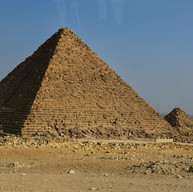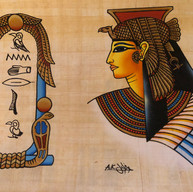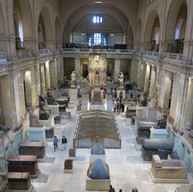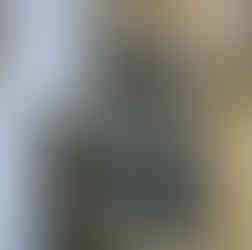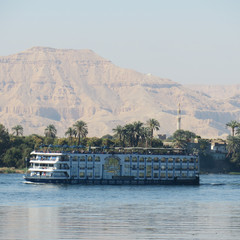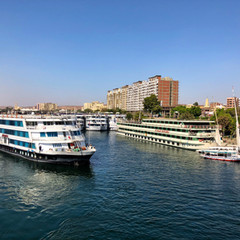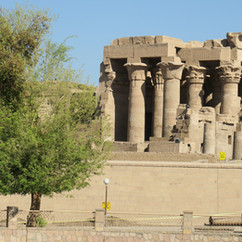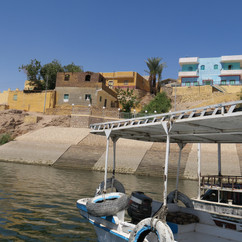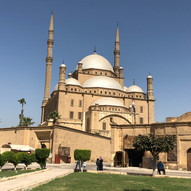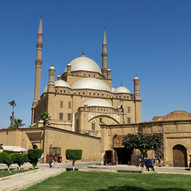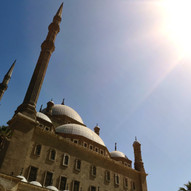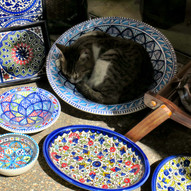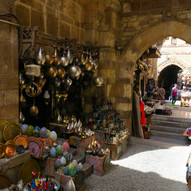Temples, Tombs, Traffic and Touts!! An Egyptian adventure.
- arthorley
- Mar 20, 2018
- 11 min read
I’d been to the Egyptian Red Sea resort of Sharm El Sheik before but I’d always wanted to do “proper” Ancient Egypt so I finally got around to booking it up, starting and ending in Cairo, the capital, on an 9 day trip from north to south!

Where to start with Cairo...it’s a huge sprawling city, dusty, dirty in parts, mixed with really ancient sites and a mass of archaeological wonders. Cairo and Giza are classed as two separate cities with a population of 25 million alone, that’s roughly the same as the whole of Australia and massive when you consider London has about 10 million and Luxor only 1 million! One of the first things I noticed is the traffic, even at midnight when my plane landed. There are literally no rules in Cairo, it’s a free for all with people pulling out and weaving in front of each other! More on this later with my unfortunate taxi ride!! Petrol is cheaper than water here so it’s not surprising everyone bloody drives and all the cars are battered with dents etc as cars are very expensive to import. It’s one of the only places where prices of cars go up in value rather than depreciate!
I stayed on the banks of the mighty Nile river, the second longest in the world after the Amazon. It was surprisingly clean! I had a great view out over the river and the urban sprawl from the Sheraton Hotel. It was Friday when I landed so the call to prayer rang out across the city around 5am from the local mosques.
I had a huge meze breakfast and then headed off around the block to find some bottled water and snacks which actually turned into a 3 hour wander and 3.5 miles later! I crossed the Nile, walked down the banks of the river and back the other side. Immediately when the locals see you are a tourist, the hawkers/touts hassle you into buying something or “come visit my shop”. They are friendly enough but VERY persistent! A really useful phrase in Arabic “laa shokran” which means no thank you and they soon enough stop. The average Egyptian only works 5 hours a day and mostly in the evening when things get busy. It’s very much a nightlife type of place. Alright for some!
Day 1
The first day we met up with Saleeb or “Sal” as he liked to be called, who turned out to be an amazing guide!! He literally knew everything and anything about ancient Egypt and was very genuine and transparent in everything he showed us. He wanted us to see the good, the bad and the actual way of life without any bias towards religion or background or place. He’s a Doctor of Archaeology and Egyptology and his native language is actually heiroglyphics which I didn’t even know was still taught!
First stop was Saqqara, known as the “stepped” pyramid and around 3000 years old. It is one of the ancient funerary structures to Coptic monasteries and was developed as the royal necropolis for the old kingdom capital of Memphis to the west. It was impressive but not the “wow” I was hoping for compared to the main pyramids of Giza. Vases were found here with organs away from the main tomb found in the temple to protect them from grave robbers. Pretty dirty on route to Saqqara, the canals were full of rubbish known as “garbage canals” by the ex corrupt government but now the new government are addressing this and the infrastructure.
Next was the main Pyramids of Giza and wow! When you first seen the 3 main pyramids in the distance the sheer size of them dwarfs the buildings around. They are actually really not in the desert but more on the outskirts of the city.
2.5 million blocks of limestone were used to build the main pyramid “Cheops” and you’re allowed inside the main one for a small fee. It was totally different to how I expected, very steep inside and claustrophobic with one way in and one way out! It’s supposed to be very cool, around fridge temperature, to keep the mummy and tomb cool in ancient times but with the tourists going in and out it was very stuffy and hot but an incredible experience going into it and climbing up to the 23rd floor where the burial chamber is. The pyramids are actually built at a certain angle so they never cast a shadow, and it’s true! Pretty cool! As the ancient Pharoah’s believed shadows were evil spirits of the underworld and the pyramids were effectively tombs or shrines to honour and protect the deceased royalty.
I had to get a classic camel ride in from a spot further away from the pyramids with a panoramic view of all three and the city behind. You can get rides closer to the pyramids but they aren’t controlled so they’ll rip you off and the views aren’t the same. Next it was onto the Sphinx which was cool but smaller than expected in real life. Each pyramid has a sphinx or series or sphinxs protecting them. The run down apartments overlooking the pyramids are now worth a cool $85 million as they are sitting on top of further sphinxs and other tombs than have been identified using the latest scientific technology. Alright for some!!
Ended the day by visiting a local Papyrus museum where they showed us how to spot the fakes which are made from banana leaves! I had my name written on some papyrus in ancient hieroglyphics.
Day 2
The morning was a visit to the famous Egyptian museum. Seriously, this country is sitting on huge amounts of wealth if ever they sold anything....the cheapest item here is worth around $14 million and the most expensive around $475 million for one of the pure gold mummified coffins. They still have about 4.8 million antiquities not even on show here and therefore the place is heavily fortified with security, scanners, cameras, heat sensors etc. They don’t have room to display everything so they are currently building a new museum which will house everything and fully open around 2021 I believe. Around 5000 mummies alone are kept in the basement of the current museum! The Tutankhamun room is obviously pretty interesting to see his gold funeral mask and the gold coffins and artifacts that were found in his small tomb in the Valley of the Kings by Luxor.
I rounded off the day with a delightful (not!) sleeper train from Giza’s main station to Luxor in the south, a lovely 10 hours in a rickety old two berth cabin, and this was considered first class really! It was ok but for me who needs total silence to sleep in, it wasn’t ideal!
Day 3
Off we went to the famous Valley of the Kings area about 30 minutes outside Luxor. This place is huge and pretty impressive! This remote area was the necropolis of the new kingdom pharaohs and by digging their tombs deep into the Theban Hills, they hoped it would stop grave robbers from stealing the priceless possessions buried inside. Despite this, every burial chamber (63 so far) but two were raided and Tutankhamun’s tomb was discovered by archaeologist Howard Carter in 1922, its treasures all still intact. Although small and unfinished as he died so young, the coffin and his body is still there which you can see for an extra fee. They are still excavating even now as they believe loads more tombs exist! They’ve even found a few recently!
Each chamber is full of corridors (generally 3 each) and hieroglyphics painted each side down towards the burial chamber depicting the accounts of that person and the journey to the underworld or the afterlife. It is really pretty cool, interesting and eerie all in one. The height of each tomb tells us how old the person was when they died.
Rameses the 3rd's tomb is pretty impressive with amazing heiroglyphics on the walls all the way down to the burial chamber. The mummy was taken but the coffin still exists. The only insect the ancient Egyptians worshipped was the Scarab Beetle and this is all over the walls.
At dusk I visited the Luxor Temple in the city itself which dominates the banks of the Nile. The temple is a great example of Pharaonic architecture dedicated to the Theban triad of Amun, Mut and Khonsu. There’s an avenue of Sphinx’s leading up to the temple and stretched nearly 2km in ancient times! The giant columns and statues are dedicated to Ramses the second and a huge 25m high obelisk flanks the gateway to this temple.
Interestingly there are so many ancient sites being discovered in Luxor that the whole population of the city is being moved to a new site north of the old city to make room for further excavations. The government are paying double the price for people’s houses to move them and the dream is for Luxor to become the worlds largest open air museum when this huge project is completed in about 10 years time!
Day 4
Further north of the Luxor Temple is the huge Karnak Temple which was dedicated to the king of the gods, Amun. With its endless courts, pillars and huge sacred lake, this temple laid buried in the sand for almost 1000 years before excavation work began in the 19th century. As well as the colossal temple of Amun, the site has an amazing array of temples, chapels, pylons and obelisks, all testifying to the importance of Thebes (Valley of the Kings etc).
After the morning visit it was time to hop aboard the Nile cruiser for the few days cruise trip down the Nile to Aswan. In peak season (around Oct-Dec), 1100 of these cruisers and felucca boats go up and down the river. There were enough even in March that to get from one boat to another, they stack themselves up along side each other and you walk through each one before you get to your own! They are pretty nice, like 4 star floating hotels with a roof terrace and swimming pool on top and all rooms facing outwards onto the Nile.
Talk about trying to be different, even the hawkers here have a novel idea of trying to sell you their stuff....they hook their small rowing boats onto the side of the big cruisers and start yelling so everyone on the top deck looks over. They then show you their goods whilst putting them in a bag and lobbing them up so they land on the top deck! It was pretty funny watching them haggle with us all from the top deck whilst throwing anything back we didn’t want! You put the money in the bag and throw it back down. Was fun to watch and be part of! They have definitely got this town to a tea! God knows how they get back up the Nile in their rowing boat as they were attached both sides for about an hour whilst we cruised along! We crossed through the big lock near Edfu and docked for the night.
Day 5
The next day we got a horse and cart to the temple in Edfu. The journey there was definitely not a highlight of the trip! The poor horses aren’t kept in great condition and their owners weren’t particularly friendly, aggressive in their approach. We saw a few horses fall over and it was pretty sad to see. We even saw a few fights breaking out amongst the locals, have no idea what about! Definitely the most unfriendly people compared to the rest of Egypt!
The Temple of Horus in Edfu itself was nice and interesting despite the chaos outside. It was an important site to the ancient Egyptians because this is where the falcon-god Horus fought a fierce battle with his uncle Seth who had murdered Horus’s father Osiris. The temple itself was buried under sand for nearly 2000 years and is the largest and best preserved Ptolemiac temple in Egypt. There’s an ancient boat inside with secret tunnels and passages full of heiroglyphics.
Back on the nile cruiser it was time to relax as we headed towards the southern town of Aswan and Kom Ombo, in the Nubian lands of Egypt.
Day 6
Kom Ombo, unlike Edfu, was much more chilled and relaxed. The Temple of Kom Ombo can be seen from the Nile and is a short walk. Dedicated to the Crocodile god Sobek and the Falcon god, Horus, the temple is totally symmetrical with two entrances, two halls and two sanctuaries. You can also see some mummified ancient crocodiles here for an extra fee which isn’t really worth it, not to mention odd.
There is also reference to Cleopatra here and is the only heiroglyphic of her in ancient Egypt.
Outside in the local market I haggled with the hawkers to get some traditional dress for the Arabian night on board the cruiser that night. Needless to say, the local waffle of “this is 100% cotton sir” was clearly “100% polyester or mostly polyester” and would have gone up in flames had someone come near me with a lighter! I haggled him down and left with a traditional Galabiyya outfit and headscarf!
Day 7
Arriving into Aswan at night, we were up early to visit the Aswan High Dam and the Nubian lands. 75% are Coptic Christians here compared to 55% in Luxor. The huge dam is the main source of all power and electricity for all of Egypt so it is highly secured by the army and heavily fortified all around. It was built in 1960 and was to regulate the flow of the Nile. You have the huge Lake Nassar on one side with big steel nets in the lake to keep out the 200,000 Nile crocodiles! The dam was impressive but in terms of looks, it’s not as impressive as the Hoover Dam near Las Vegas or the Strathgordon Dam in Tasmania.
Afterwards we went to visit the Philae Temple which you get to by hopping on a small boat across a lake. This temple was dedicated to the goddess of Love, Isis.
Late afternoon we hopped on a local Felucca boat and cruised around Aswan on the Nile which was soooo chilled! You can see the famous Cataract Hotel which is where Agatha Christie wrote her novel “Death on the Nile”. We had a young boy paddle over to us on a surf board and started singing (badly!) to get a tip!
Day 8
The last day in Aswan was chilling on the boat before the long overnight sleeper train journey back to Cairo. Aswan is such a chilled place and nice to wander around the local markets.
Day 9
Arriving into Cairo around 9am, we went straight and did a city tour of Old Cairo, the Islamic and Coptic areas. The mosque of Mohammed Ali Pasha on top of the hill also known as the walled Citadel, was home to Egypt’s rulers for almost 700 years. It’s beautiful inside and out and gives far reaching views across the urban sprawl of Cairo. You can even see the pyramids of Giza and Saqqara from their in the distance about 38km away through the haze!
The Coptic area home to the orthodox Christians houses the famous Hanging church (Africa’s and Egypt’s oldest/first church) as the Jewish synagogue. The Hanging Church is the only place in the world where is shows angles as females not males. It was great to see another part of Egypt other than temples and tombs.
Finally we wanted to go and see the famous Khan el Khalili bazaar. I’d always wanted to find a proper “Aladdin’s Cave” type bazaar and this didn’t disappoint! A real Arabian feeling with cobbled streets, arches and winding walkways where the main draw is copper, brass, and sacks overfilling with spices etc, and a much more chilled environment in which to haggle!
The journey there was a bit traumatic as the nightmare that is the Cairo traffic, a car pulled out in front of our taxi driver (as the always do) and our taxi went smash into the side of him, writing off his car! Thankfully we were all ok apart from a bump to the head but it could have been a lot worse. No seatbelts and crazy driving!!
Overall, Egypt’s a fascinating and amazing country and people shouldn’t be put off by things that the media report. The people overall are friendly and I didn’t feel unsafe at all (apart from the taxi ride!). So much history and just make sure you get a good guide who knows what they are talking about as it makes all the difference. It makes me want to learn Heiroglyphics now!

































